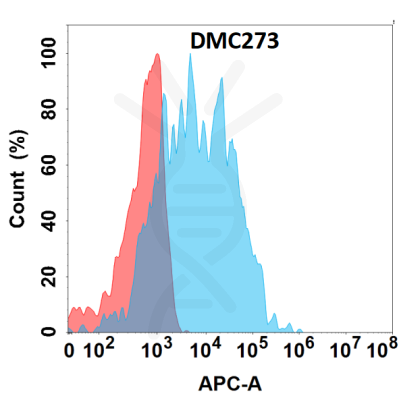| TARGET | |
|---|---|
| SYNONYMS |
BDPLT10; CHDS7; FAT; GP3B; GP4; GPIV; PASIV; SCARB3 |
| HOST SPECIES |
Rabbit |
| DESCRIPTION |
Anti-CD36 antibody(DMC273); IgG1 Chimeric mAb |
| DELIVERY |
In Stock |
| UNIPROT ID |
P16671 |
| IGG TYPE |
Rabbit:Human Fc chimeric IgG1 |
| CLONALITY |
Monoclonal |
| REACTIVITY |
Human |
| APPLICATIONS |
Flow Cyt |
| RECOMMENDED DILUTIONS |
Flow Cyt 1:100 |
| PURIFICATION |
Purified from cell culture supernatant by affinity chromatography |
| FORMULATION & RECONSTITUTION |
Lyophilized from sterile PBS, pH 7.4. Normally 5 % – 8% trehalose is added as protectants before lyophilization. Please see Certificate of Analysis for specific instructions of reconstitution. |
| STORAGE & SHIPPING |
Store at -20°C to -80°C for 12 months in lyophilized form. After reconstitution, if not intended for use within a month, aliquot and store at -80°C (Avoid repeated freezing and thawing). Lyophilized proteins are shipped at ambient temperature. |
| BACKGROUND |
The protein encoded by this gene is the fourth major glycoprotein of the platelet surface and serves as a receptor for thrombospondin in platelets and various cell lines. Since thrombospondins are widely distributed proteins involved in a variety of adhesive processes; this protein may have important functions as a cell adhesion molecule. It binds to collagen; thrombospondin; anionic phospholipids and oxidized LDL. It directly mediates cytoadherence of Plasmodium falciparum parasitized erythrocytes and it binds long chain fatty acids and may function in the transport and:or as a regulator of fatty acid transport. Mutations in this gene cause platelet glycoprotein deficiency. Multiple alternatively spliced transcript variants have been found for this gene. |
| USAGE |
Research use only |
1
/
의
1
Dima Biotech
SKU(재고 관리 코드):DMC100273
Anti-CD36 antibody(DMC273), IgG1 Chimeric mAb
Anti-CD36 antibody(DMC273), IgG1 Chimeric mAb
PRODUCT DATA
IMAGES

Figure 1. Flow cytometry analysis with Anti-CD36 (DMC273) on Expi293 cells transfected with human CD36 (Blue histogram) or Expi293 transfected with irrelevant protein (Red histogram).
Share


